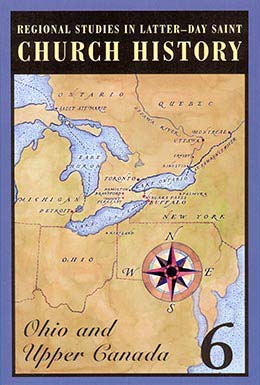Introduction
Guy L. Dorius, Craig K. Manscill, and Craig James Ostler, introduction to Regional Studies in Latter-day Saint Church History: Ohio and Upper Canada, ed. (Provo, UT: Religious Studies Center, Brigham Young University, 2006), v–vii.
Guy L. Dorius, Craig K. Manscill, and Craig James Ostler were associate professors of Church history and doctrine when this was published.
Ohio became the first gathering place for the Saints in this dispensation when the Lord declared, “A commandment I give unto the church, that it is expedient in me that they should assemble together at the Ohio” (D&C 37:3). Members of the Church in New York responded to this command by gathering in and around Kirtland, Ohio, where the Lord promised that He would give them His law and endow them with power. Ohio became a place where the Lord opened the heavens and gave the promised endowment. Revelation was abundant and sometimes accompanied by the Lord’s presence. Keys were restored and priesthood organized as the kingdom rolled forth. For example, from Ohio the message of the Restoration of the gospel was taken into Ontario, Canada. In October 1833 the Prophet Joseph Smith and other companions traveled to Mount Pleasant, and later Elder Parley P. Pratt was sent on a mission to Toronto. Among the many who joined the Church were John Taylor and Mary Fielding.
In the summer of 2004, members of the Church History and Doctrine faculty at Brigham Young University gathered at “the Ohio” to present research and travel to all of the major sites related to Latter-day Saint history. The sites were viewed not only from a historical perspective but also in relation to the Doctrine and Covenants. Almost half of the revelations in the Doctrine and Covenants were received in Ohio. This experience enriched both historians and teachers of the scriptures. The faculty continued in their journey to Canada and learned on-site regarding the introduction and growth of the Church in that corner of the Lord’s vineyard. This volume of Regional Studies contains seven essays dealing with various topics germane to Church history in Ohio and three on the early Church in Ontario.
In “A Most Remarkable Family: The Ohio Legacy of the Asael and Mary Duty Smith Family,” David F. Boone provides insights into this remarkable family and its history. Mary Duty Smith’s reunion with her family in Kirtland and her death are documented, placing her important role in its final context.
Richard O. Cowan presented “Faith and Devotion in Building the Kirtland Temple” from the pulpit of the Kirtland Temple while there with the faculty. His essay delves into the construction and the faith involved in the Kirtland Temple construction. Professor Cowan also shares accounts of the dedicatory experiences of the Saints.
H. Dean Garrett highlights the effects of the missionaries to the Lamanites as they passed through the Kirtland region in “The Messengers and the Message: Missionaries to the Lamanites in Ohio.” He deals not only with the history of their stopover in the region but also the power of their message.
The challenges inherent in the tensions between acting on revelation received from a prophet and free will are addressed by Steven C. Harper in “‘Every Man Walketh in His Own Way’: Individualism, Revelation, and Authority in the Ohio Period.” Professor Harper examines culture and theology as factors that contribute to these issues in the lives of the individuals who lived in the Ohio period of Latter-day saint history.
Craig James Ostler provides the reader with a virtual tour of Kirtland through his paper, “Church History Sites in Kirtland, Ohio: A Photo Essay.” With dozens of photos and accompanying descriptions, Dr. Ostler frames this important area and provides visuals of the Restoration.
Kip Sperry’s “Religion and Ethnicity in the Western Reserve” provides detailed insights into the establishment of the Western Reserve and its diverse groups of settlers. He pays special attention to the religious backgrounds of its inhabitants and enumerates family history depositories in the region.
Completing the Ohio section of the volume is “Caroline Young Harris: The Kirtland Wife of Martin Harris.” Author Dennis A. Wright shares the history of Caroline Young, Martin Harris’s second wife, whom he married in the Kirtland era. This paper highlights this witness of the Book of Mormon and his family life.
Craig James Ostler and William Goddard provide important documentation of Joseph Smith’s rare missionary excursion to Upper Canada in “A Brief History of the Church in the Mount Pleasant Area, Ontario, before 1850.” This work details the names and places associated with this mission which was exceptional not only for the people it influenced but also for its international reach.
“William Lyon Mackenzie and the Mormon Connection” by Helen Warner examines the relationship that existed between a controversial Canadian politician and the Latter-day Saints during the Kirtland era of Church history. This piece reveals the philosophical views that Mackenzie held and his apparent attraction to Mormon thought.
The final essay in this volume, “Of Printers, Prophets, and Politicians: William Lyon Mackenzie, Mormonism, and Early Printing in Upper Canada,” by Richard E. Bennett and Daniel H. Olsen offers more detailed insights into the possible relationship between Mackenzie and Parley P. Pratt. Central to this concern are issues related to the copyright for the Book of Mormon and other printing efforts in Upper Canada.
We express our appreciation to Andrew C. Skinner and Paul H. Peterson, who respectively served as dean of Religious Education and chair of the department of Church History and Doctrine when the faculty traveled to Ohio and Upper Canada in 2004, for their support in this publication. Our gratitude is extended to Terry B. Ball and Arnold K. Garr, current dean and chair for their continued support. We acknowledge the Religious Studies Center for their work in preparing this volume for publication and especially the efforts of Anjylei Carlson, who served as research assistant on this project.
Guy L. Dorius
Craig K. Manscill
Craig James Ostler
Editors
